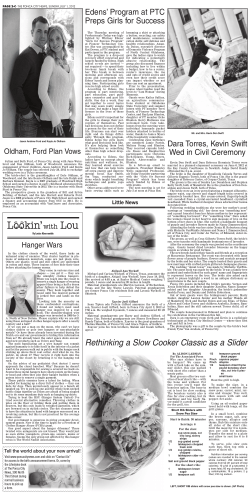
Mallorys Reach Gold Couple Married 60 Years
THE PONCA CITY NEWS, SUNDAY, OCTOBER 30, 2011–PAGE 3-C Frugal Living Sara Noel Sara Noel ©2011 www.frugalvillage.com Mr. and Mrs. David Mallory Mr. and Mrs. Robert Lewis Koger Couple Married 60 Years Mr. and Mrs. Robert Lewis Koger celebrated their 60th wedding anniversary on Oct. 21. Robert Lewis Koger and Ethel Ilene Montgomery were married Oct. 21, 1951, by the Rev. Charlie Shedd in Ponca City. They have lived in Ponca City since 1955. The occasion was celebrated with a surprise party given by their family at the 40th reunion of the Clan Montgomery, held at the Shady Hills Ranch. They are the parents of four children: Norman Koger, Robert Koger, Lynn Koger Lindsay and husband Robert, all of Winnemucca, Nev., and Larry Koger and wife Donna, Wichita, Kan. The couple has seven grandchildren, 15 great-grandchil- Robert Lewis Koger and Ethel Ilene Montgomery dren and one great-great grandchild. How To Stop Your Dog From Jumping at Door LOS ANGELES (AP) — Thanksgiving and Christmas often involve visits from family and friends, but unless your dog keeps all four on the floor, you might be the one in the doghouse. Some people will be frightened by a dog that greets guests at the door by jumping up. Others may be allergic, frail or easily knocked off balance. A pawmark or doggy drool on guests’ clothing is embarrassing, and while some visitors will say they love dogs and it’s no big deal, others will be annoyed. Diane Morgan, who includes jumping up in her book “Complete Guide to Dog Care” from Animal Planet and TFH Publications, says dogs can be trained out of jumping at the door. But it takes time and patience and you may need to try different strategies to find one that works. Tucker, a 50-pound Labradoodle, can “sit, shake, high-five, lay down, roll over, stay, heel, do all that stuff,” said owner Mike Pentz, who lives in Columbus, Ohio. “The only time he doesn’t listen is at the front door.” Pentz and his wife Yvonne worked with trainers using clickers, a leash, and commands to try to stop the behavior, but nothing worked. Finally they resorted to putting him in the laundry room when company arrives. Now, Pentz says, when the bell rings, Tucker runs to the laundry room and “waits for me to close the door.” Once guests have settled in, Tucker comes out, checks everyone out and lies down. But Morgan doesn’t recommend putting a dog in another room as a way to prevent jumping at the door, because it can lead to other problems like whining, scratching or barking. “Dogs are very pragmatic creatures. They do what works, what earns them rewards,” she said. Most want attention, so even simply telling the dog to stop or get down can be interpreted by the dog as attention. The goal is to refocus the attention. About 85 percent of dogs care about treats and 15 percent care about toys, she said, so use what amuses your pet the most. Here are some of Morgan’s techniques: — Have a treat or toy in your hand when you walk in the door. Instantly throw it on the floor. The dog will soon understand that the best way to get the treat is to look on the floor, not to jump up. — Teach the dog to sit. Once he is still, throw a treat on the floor. — Try walking in the door with a can or jar of pennies. “Shake it really hard. It acts as a warning or signal to stay away.” — Put the dog on a short leash and keep him at your side. “Have people get down low to greet him.” — Walk in and ignore the dog. If you don’t give him attention, he will stop. Morgan added this warning: “He may become frantic at first and try harder and might ruin your clothes.” You may have to cross your arms and turn your back on the dog to be sure he gets the message. — Last resort: When the dog jumps up, take him by his front legs and hold him like you are dancing. He will be real happy for about two seconds, then want down. Keep holding for several more seconds. Dogs don’t like staying on their hind legs. With repetition, the dog will get the idea. No matter what method you try, “it will only work if everybody in the house is involved,” Morgan said. Take turns leaving the house and coming back, repeating the treat, the dance, the chilly reception or the noise, whatever you’ve chosen. In addition, she said, before guests arrive, “make sure your dog has access to toys and things he likes. Make sure he gets some healthy exercise before dinner. Wear him out. The more tired he is before guests arrive, the better behaved he will be after. Make sure he is bathed and clean. You don’t want the dog to smell bad. And make sure his toenails are clipped in case he does jump.” Wheatheart Nutrition Menu Ponca City’s Wheatheart Nutrition Project is one of several Kay County locations providing hot lunches for area citizens age 60 and over. Located at 319 West Grand, the meals are served Monday through Friday from 11:30 a.m. to noon. Friday meals are a sack lunch. Monday, Oct. 31: Chicken rice casserole, seasoned green beans, lettuce salad with tomatoes, white roll with margarine and chilled peaches for dessert. Tuesday, Nov. 1: Vegetable meat loaf, potato cheese casserole, winter mix veggies, French bread with margarine and pineapple upside-down cake for dessert. Wednesday, Nov. 2: Ham and beans with club spinach, stewed tomatoes, cornbread with margarine, and tropical fruit for dessert. Thursday, Nov. 3: Riblett sandwich with sliced pickles, broccoli and cabbage slaw, corn relish and chocolate pudding for dessert. Friday, Nov. 4: Sack lunch of vegetable beef soup, peanut butter and crackers, orange juice, cookie and pudding. Mallorys Reach Gold David and Jane Mallory will celebrate their 50th wedding anniversary on Nov. 2, 2011. The couple met in accounting lab while students at North Texas University in Denton, Texas. David L. Mallory and the former Jane L. Foster were married in his parents’ home in Dallas on Nov. 2, 1961. David was on a 10-day leave from the call-up of the Army National Guard. He had a 30-year career with Conoco in the retail credit card department. The family moved several times before his retirement. Jane’s skills as an executive secretary made her a soughtafter employee wherever the family was transferred. She worked for United Telecom at the time of her retirement. She now enjoys spending her free time playing music, solving crossword puzzles, crafting, baking, knitting, reading and working in her perennial garden. David enjoys a number of volunteer activities. The couple has been members of Northeast Baptist Church for many years and have served in many areas. The Mallorys will celebrate their golden anniversary with a family reunion at Great Wolf Lodge in Kansas City, Kan. David and Jane Mallory Their children are Chris Mallory and wife Lisa, of Chicago, and Cathy Burnett and husband Jason, of Ponca City. They have six grandchildren, Bree Glaser, of Stillwater; Michael, Madison and Christopher Wayne Mallory, of Chicago; and Taylor Marie and Grant Burnett, of Ponca City. The couple requests no gifts, please, but welcome visitors and greetings. “A simple e-mail, note or ‘hello’ is good,” David said, “as your friendship is important to us.” Half of Teens Shy, But For A Few, It’s More Serious By LAURAN NEERGAARD AP Medical Writer WASHINGTON (AP) — Does your teen show normal nerves about the weekend party, or always stay home? Nearly half of teenagers say they’re shy, perhaps a bit surprising in our say-anything society. But a government study finds a small fraction of those teens show signs of a troubling anxiety disorder that can be mistaken for extreme shyness. The report challenges criticism that the terms “social phobia” or “social anxiety disorder” medicalize normal shyness. “Shyness is a normal human temperament,” says lead researcher Dr. Kathleen Merikangas of the National Institute of Mental Health, whose teachers always noted her own childhood shyness on her report cards. But just as it can be hard to tell when feeling sad turns into depression, “there is a blurred boundary between people who describe themselves as shy and clinically significant impairment,” Merikangas adds. The difference: The shy can be drawn out and adapt, while teens or adults with fullfledged social anxiety become so paralyzed during social situations that it interferes with everyday functioning. “I didn’t go out on dates or do any of the things that other kids did,” recalls Cynthia Kipp of Tehachapi, Calif., who shared her story of years struggling with social phobia with the Anxiety Disorders Association of America. Now 48, she thinks her first anxiety symptoms began in fourth grade, when she can remember hiding under her coat in class, but worsened in high school when she tried drugs and alcohol for relief. Eventually she found treatment that worked. Getting children to school can be stressful. Organization not only makes mornings run more smoothly (which is especially helpful on days when you’re running late), but it teaches young children valuable life skills. Put a few tools and systems in place, and soon your kids will be able to manage effortlessly on their own. Communication center: Set up an area in your home to organize family information. This keeps everyone on the same page. This area should contain the following: — Calendar. Hang a paper calendar so everyone can see what is going on and when. You can use online calendars, too. Set up reminders so you don’t forget any important dates. — Folders. Each family member can have one. Important documents can go directly into the folders, preventing misplaced paperwork. It’s easy to go through a neat folder and know what to add to the calendar and what to keep, toss or discuss. Have kids use a school planner for homework and school projects, too. Check their homework and initial their planners. — Dry erase board. Anyone can leave a quick note or reminder. You can include shopping lists, to-do lists, phone numbers, chores or missed phone calls. — Hooks and bins. Use hooks for the most often-used backpacks, jackets, hoodies or coats. It’s much easier to place and pick up these items if they’re always in one spot. Have kids bring their lunchboxes to the kitchen and their activity bags to the laundry room, so their active wear can be washed and repacked in the bag. One reader, Debbie E. from New Jersey, shares: “I have bins for each child. They put their backpacks in the bins when they finish their homework. I have a clipboard hooked onto the wall for each school-age child. Any class lists, sports schedules or papers that need to be signed get posted there. You can also do this with a three-ring binder.” — Table. Use for items such as cellphones, iPods and laptops. You can place smaller organizers on the table, such as baskets or even a shoebox, for keys, lunch money and wallets. Organizers: Consider daysof-the-week clothes organizers or outfit hangers for young children. Use a shoe organizer (an old bookshelf will work), so your morning isn’t spent looking for a misplaced shoe. Use an over-the-door organizer for winter hats and mittens. Organizers and containers don’t have to be fancy. Reuse baby-wipes containers, glass jars or a plastic ice-cream tub. A simple clothespin can be clipped to a purse, placemat, lunchbag or backpack to serve as a reminder to do some- thing. You can even write a note on the clothespin with permanent marker. Create a study area: The location can be anywhere you choose, but include an area such as a closet shelf or Rubbermaid tote to keep school supplies handy. Investing in an electric pencil sharpener is money well spent. Rules and checklist: This can include a weekly meal plan, chores, instrument practice or bedtime routines. Meals and snacks: Designate a pantry or cabinet shelf specifically for lunch foods. In time, even young children can pack their own lunches. Get into the habit of making lunches the night before and including extra healthy snacks your kids can eat when they get home or on their way to activities. Have a few graband-go breakfast foods handy in a container for mornings when you’re running late. Family meetings: Whether it’s a small discussion daily over dinner or a more formal meeting once a week (Sundays often work best), all family members must communicate to help things stay on track and keep everyone updated. Any scheduling conflicts or changes that are needed can be discussed before the upcoming week begins. Plastic cereal bags are great liners that can be reused. You can use them to store baked goods or a sandwich, apply breadcrumb coatings to meat, fish and poultry, roll up cookie dough logs, contain ingredients to be crushed with a rolling pin, or as a trash container in your car. The first reader tip shares another use: Reuse cereal bags: I use cereal bags as a cutting board when I only have one or two things to chop. It also saves washing another cutting board when I’m in a hurry. — Veronica, email Use for odd socks: So what if all your odd socks don’t match! Okay, maybe you shouldn’t wear them at work, but for weekends and hanging out, why not? They can also be altered and turned into wrist warmers (insulation for wrists in winter). — Colin, email Reuse old shower curtain: We cleaned up our old clear vinyl shower curtain and tightly stapled it to a piece of plywood. Our son uses it as a huge dry erase board. — Mary, email Inexpensive or homemade gift ideas for kids: Melt leftover or broken crayons in shaped muffin tins to make fun, multi-colored, shaped crayons! Instead of buying overpriced Easy-Bake oven mixes, search Google for recipes and make a recipe book. You can prepare and package some of the dry mixes for the child to use right away. — S.G., Pennsylvania Invest in kitchen helpers: I used Christmas money to invest in timesavers for the kitchen. Little News McCord Senior Center Menu The McCord Senior Citizens Center, 115 East Mary Road, serves hot, home-cooked, balanced lunches prepared at the Center each weekday from 11 a.m. to 12:30 p.m. Lunch is available to all regardless of age or address. Donations of $3.50 a meal for those over 55 are appreciated. Suggested donation for those under 55 is $5 and $2.50 for children under 12. Homebound citizens living in Osage County and within a five-mile radius of McCord Senior Center can receive meals delivered to their door. Call the center, 762-9350, if you are interested in this service. Country Notes band plays every Tuesday starting at 10:30 a.m. and card play begins at 12:30 p.m. Every Thursday is bingo. Volunteers are needed. Those interested are welcome to call Betty, 762-7797, for more information. The menu for this week is: Monday, Oct. 31: Bats in a kettle with ghostly squares or quarter-moon droppings, spooky spiders, blood and guts. Tuesday, Nov. 1: PLAY CARDS — Chicken and noodles, mashed potatoes, fried okra, salad, hot rolls and dessert. Wednesday, Nov. 2: Biscuits and gravy, sausage patty, scrambled egg casserole, hash browns and fruit. Thursday, Nov. 3: PLAY BINGO — Fried chicken, potato salad, baked beans, cole slaw, salad, bread and dessert. Brynn Anistan Rutz Brandon and Erin Rutz, Ponca City, announce the birth of their daughter, Brynn Anistan Rutz, on Oct. 17 at 6:06 p.m. at Ponca City Medical Center. The baby weighed 6 pounds, 2 ounces and measured 18 1/2 inches long. Grandparents are Paula Slater of Ponca City, Daryl and Sheila Slater of Tulsa, and Bill and Betty Rutz, Ponca City. The baby has one brother, Braydon, 8, and one sister, Madison, 6. Mackenzie Grace Kyler Ross and Kalyn Kyler, Ponca City, announce the birth of their daughter, Mackenzie Grace Kyler, on Oct. 19 at 3:34 p.m. at Ponca City Medical Center. The baby weighed 7 pounds, 14 ounces and measured 19.5 inches long. Maternal grandparents are Roger and Kathy Summars of Buffalo. Paternal grandparents are Randy and Lynnette Kyler of Pawhuska. Great-grandparents of the baby are Carroll and Darlene Jones of Buffalo, Dorla Summars of Woodward and Richard and Patsy Hileman of Wynona. She has two sisters, Addison, 4, and Haylee, 3. Friday, Nov. 4: Cabbage rolls, scalloped potatoes, corn, salad, hot rolls and dessert. Coming Out of Retirement! NORTHCUTTS AND STYLES 1413 East Hartford, Ponca City Carla Pemberton, Stylist Call or e-mail for your appointment (580) 763-0404 or (580) 762-2163 [email protected] Dinner And Bazaar This Wednesday, Nov. 2 Braman United Methodist Church, 120 Eaton Sale items available in foyer at 4 P.M. Dinner from 5 to 7 P.M. Auction at 7 P.M. FEATURED ITEM: 1936 Friendship Quilt Plus handmade quilts and many other items Adults $6.50 • Children 4-11 $3.00 • Under 4 Free
© Copyright 2025











